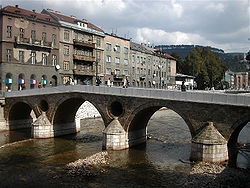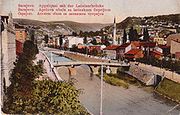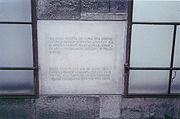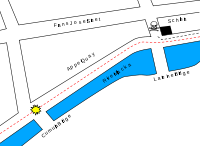
Latin Bridge in Sarajevo
Encyclopedia

Ottoman Empire
The Ottoman EmpireIt was usually referred to as the "Ottoman Empire", the "Turkish Empire", the "Ottoman Caliphate" or more commonly "Turkey" by its contemporaries...
bridge
Bridge
A bridge is a structure built to span physical obstacles such as a body of water, valley, or road, for the purpose of providing passage over the obstacle...
over the River Miljacka
Miljacka
The Miljacka is a river in Bosnia and Herzegovina that passes through Sarajevo and East Sarajevo. It is famous for being "Sarajevo's River", and it has come to be identified immediately with the city itself....
in Sarajevo
Sarajevo
Sarajevo |Bosnia]], surrounded by the Dinaric Alps and situated along the Miljacka River in the heart of Southeastern Europe and the Balkans....
, Bosnia and Herzegovina
Bosnia and Herzegovina
Bosnia and Herzegovina , sometimes called Bosnia-Herzegovina or simply Bosnia, is a country in Southern Europe, on the Balkan Peninsula. Bordered by Croatia to the north, west and south, Serbia to the east, and Montenegro to the southeast, Bosnia and Herzegovina is almost landlocked, except for the...
. The northern end of the bridge was the site of the assassination of Archduke Franz Ferdinand of Austria
Archduke Franz Ferdinand of Austria
Franz Ferdinand was an Archduke of Austria-Este, Austro-Hungarian and Royal Prince of Hungary and of Bohemia, and from 1889 until his death, heir presumptive to the Austro-Hungarian throne. His assassination in Sarajevo precipitated Austria-Hungary's declaration of war against Serbia...
by Gavrilo Princip
Gavrilo Princip
Gavrilo Princip was the Bosnian Serb who assassinated Archduke Franz Ferdinand of Austria and his wife, Sophie, Duchess of Hohenberg, in Sarajevo on 28 June 1914...
in 1914, which became a casus belli
Casus belli
is a Latin expression meaning the justification for acts of war. means "incident", "rupture" or indeed "case", while means bellic...
of World War I
World War I
World War I , which was predominantly called the World War or the Great War from its occurrence until 1939, and the First World War or World War I thereafter, was a major war centred in Europe that began on 28 July 1914 and lasted until 11 November 1918...
.
History

Islamic calendar
The Hijri calendar , also known as the Muslim calendar or Islamic calendar , is a lunar calendar consisting of 12 lunar months in a year of 354 or 355 days. It is used to date events in many Muslim countries , and used by Muslims everywhere to determine the proper day on which to celebrate Islamic...
equals the year of the reconstruction 1798/99.
The bridge has four arches and rests on three strong pillars
Column
A column or pillar in architecture and structural engineering is a vertical structural element that transmits, through compression, the weight of the structure above to other structural elements below. For the purpose of wind or earthquake engineering, columns may be designed to resist lateral forces...
and the embankment; it is built of stone and gypsum
Gypsum
Gypsum is a very soft sulfate mineral composed of calcium sulfate dihydrate, with the chemical formula CaSO4·2H2O. It is found in alabaster, a decorative stone used in Ancient Egypt. It is the second softest mineral on the Mohs Hardness Scale...
and the two relieving openings, 'eyes' in the mass above pillars are so characteristic that they can be seen in the seal of Sarajevo. Because of heavy traffic at the time of Austria-Hungary
Austria-Hungary
Austria-Hungary , more formally known as the Kingdoms and Lands Represented in the Imperial Council and the Lands of the Holy Hungarian Crown of Saint Stephen, was a constitutional monarchic union between the crowns of the Austrian Empire and the Kingdom of Hungary in...
, the pavements on consoles were added to the bridge.
Assassination

Gavrilo Princip
Gavrilo Princip was the Bosnian Serb who assassinated Archduke Franz Ferdinand of Austria and his wife, Sophie, Duchess of Hohenberg, in Sarajevo on 28 June 1914...
shot Austro-Hungarian
Austria-Hungary
Austria-Hungary , more formally known as the Kingdoms and Lands Represented in the Imperial Council and the Lands of the Holy Hungarian Crown of Saint Stephen, was a constitutional monarchic union between the crowns of the Austrian Empire and the Kingdom of Hungary in...
throne-heir Franz Ferdinand
Archduke Franz Ferdinand of Austria
Franz Ferdinand was an Archduke of Austria-Este, Austro-Hungarian and Royal Prince of Hungary and of Bohemia, and from 1889 until his death, heir presumptive to the Austro-Hungarian throne. His assassination in Sarajevo precipitated Austria-Hungary's declaration of war against Serbia...
, which was the immediate cause for the beginning of the First World War. The bridge was renamed after Princip during the Yugoslavian era and renamed back to the Latin Bridge after the Yugoslav Wars
Yugoslav wars
The Yugoslav Wars were a series of wars, fought throughout the former Yugoslavia between 1991 and 1995. The wars were complex: characterized by bitter ethnic conflicts among the peoples of the former Yugoslavia, mostly between Serbs on the one side and Croats and Bosniaks on the other; but also...
.
Princip's testimony

Prosecution: Did you know that there was a Muslim?
Accused: I knew, but he didn't tell me. I saw him one evening. On the day of the assassination I wanted to find someone who would not be conspicuous, and I found the son of the prosecutor, Svara, and one Spiric. First I walked with Spiric. Then we invited Svara and we walked and talked about ordinary things. At first we were in the park and I wanted to stay there, but they wanted to go to the Korso (a promenade). I didn't want to stay there because I had to go to my place. So I returned there and I walked on the quay and I was at my assigned place. The automobile arrived and I heard the blast of a bomb. I knew that that was one of ours, but I didn't know which one. The mob started to run, and I ran a little too and the automobile stopped. I thought that it was over and I saw that they had Cabrinovic. I thought that I would kill him so that no one would know anything further, and then kill myself, too. I abandoned that idea, because I saw that the automobiles passed by. Up to then I had not seen the Archduke. I went to the Latin Bridge and then I heard that the assassination had not succeeded. Then I took thought as to where to stand, because I knew where he would pass from having read it in the Bosanska Posta (Bosnian Post) and the Tagblatt. Then I saw that a lady was sitting with him, but because they passed so fast I did not know whether she was sitting. Then I stood and one Pusar came up to me and touched my bumcheeks and said, "Do you see how dumb they are?" I was silent. He called me aside and because I thought he was a spy I thought that he wanted to get something out of me. A relative of his is a spy, so I thought that he was too. I don't know whether or not he was near me, but then the automobile came and I took out the revolver and I shot at Ferdinand twice from the distance of four or five paces.

